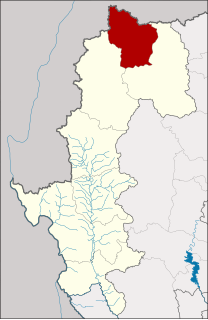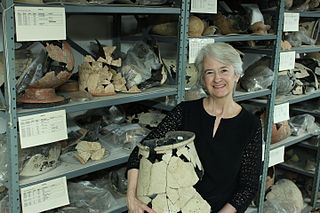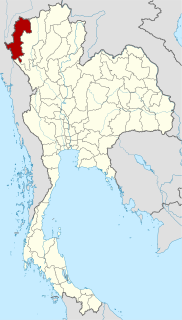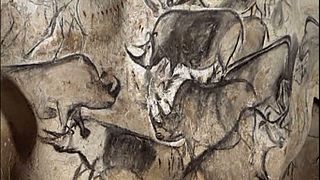
The Stone Age was a broad prehistoric period during which stone was widely used to make implements with an edge, a point, or a percussion surface. The period lasted roughly 3.4 million years and ended between 8700 BCE and 2000 BCE with the advent of metalworking.

The Khorat Plateau is a plateau in the northeastern Isan region of Thailand. The plateau forms a natural region, named after the short form of Nakhon Ratchasima, a historical barrier controlling access to and from the area.

Ban Chiang is an archeological site in Nong Han District, Udon Thani Province, Thailand. It has been on the UNESCO World Heritage list since 1992. Discovered in 1966, the site attracted enormous publicity due to its attractive red painted pottery.
The term Hòa Bình culture was first used by French archaeologists working in Northern Vietnam to describe Holocene period archaeological assemblages excavated from rock shelters. The related English adjective Hoabinhian has become a common term in the English-based literature to describe stone artifact assemblages in Southeast Asia that contain flaked, cobble artifacts, dated to c. 10,000–2000 BCE. The term was originally used to refer to a specific ethnic group, restricted to a limited period with a distinctive subsistence economy and technology. More recent work uses the term to refer to artifacts and assemblages with certain formal characteristics.

The Sa Huỳnh culture or Sa Huyun was a culture in modern-day central and southern Vietnam that flourished between 1000 BC and 200 AD. Archaeological sites from the culture have been discovered from the Mekong Delta to Quang Binh province in central Vietnam. The Sa Huynh people were most likely the predecessors of the Cham people, an Austronesian-speaking people and the founders of the kingdom of Champa.

Tabon Man refers to remains discovered in the Tabon Caves in Lipuun Point in Quezon, Palawan in the Philippines. These were discovered by Robert B. Fox, an American anthropologist of the National Museum of the Philippines, on May 28, 1962. These remains, the fossilized fragments of a skull and jawbone of three individuals, were believed to be the earliest human remains known in the Philippines which date back to 16,500 years ago, until a metatarsal from the Callao Man discovered in 2007 was dated in 2010 by uranium-series dating as being 67,000 years old. The Tabon fragments are collectively called "Tabon Man" after the Tabon Cave, the place where they were found on the west coast of Palawan. Tabon Cave appears to be a kind of Stone Age factory, with both finished stone flake tools and waste core flakes having been found at four separate levels in the main chamber. Charcoal left from three assemblages of cooking fires there has been Carbon-14-dated to roughly 7000, 20,000, and 22,000 BCE.
Charles Frank Wandesforde Higham is a British-born New Zealand archaeologist most noted for his work in Southeast Asia. Among his noted contributions to archaeology are his work about the Angkor civilization in Cambodia, and his current work in Northeast Thailand. He is a research professor at the University of Otago in Dunedin.

Pang Mapha is the northernmost district (amphoe) of Mae Hong Son Province, northern Thailand.

Before the Tai people's southward migration from Yunnan since the 4th century, the Indochinese peninsula had already been populated by Australo-Melanesians who by around 30,000 BP had spread into all sub-regions. They left traces of the first local culture - the Hoabinhian, a name assigned to an industry and cultural continuity of stone tools and flaked cobble artifacts that appears around 10,000 BP in caves and rock shelters first described in Hòa Bình, Vietnam, later also documented in Terengganu, Malaysia, Sumatra, Thailand, Laos, Myanmar, Cambodia and Yunnan, southern China.

Prehistoric Thailand may be traced back as far as 1,000,000 years ago from the fossils and stone tools found in northern and western Thailand. At an archaeological site in Lampang, northern Thailand Homo erectus fossils, Lampang Man, dating back 1,000,000 – 500,000 years, have been discovered. Stone tools have been widely found in Kanchanaburi, Ubon Ratchathani, Nakhon Si Thammarat, and Lopburi. Prehistoric cave paintings have also been found in these regions, dating back 10,000 years.

Wilhelm G. Solheim II (1924—2014) was an American anthropologist recognized as the most senior practitioner of archaeology in Southeast Asia, and as a pioneer in the study of Philippine and Southeast Asian prehistoric archaeology. He is perhaps best known, however, for hypothesizing the existence of the Nusantao Maritime Trading and Communication Network (NMTCN), one of two dominant hypotheses regarding the peopling of the Asia-Pacific region during the Neolithic age.

The Con Moong cave is located in the Cúc Phương National Park, just south of Mọ village, in the Thanh Hóa Province, northern Vietnam. The Cúc Phương National Park administration not only manages a refuge for rare animals. The Department of Culture has also issued a certificate, that declares Con Moong prehistoric site and its surroundings as National Relics. Among these locations, the archaeological site of Con Moong cave is of central importance for the study of the Mesolithic Hoabinhian culture. In April and May 1976 Vietnamese archaeologists have excavated the site.
The 'Two Layer' Hypothesis, or immigration hypothesis, is an archaeological theory that suggests the human occupation of mainland Southeast Asia occurred over two distinct periods by two separate racial groups, hence the term 'layer'. According to the Two Layer Hypothesis, early indigenous Australo-Melanesian peoples comprised the first population of Southeast Asia before their genetic integration with a second wave of inhabitants from East Asia, including Southern China, during the agricultural expansion of the Neolithic. The majority of evidence for the Two Layer Hypothesis consists of dental and morphometric analyses from archaeological sites throughout Southeast Asia, most prominently Thailand and Vietnam. The credibility of the Two Layer Hypothesis has been criticized due mainly to similarities between Southeast Asian and Chinese cranial and dental characteristics, excluding Australo-Melanesians.

Tham Lod Rockshelter, first researched by Rasmi Shoocongdej from Silpakorn University, funded by the Thai Research Fund, was a prehistoric cemetery and a workshop located in Northern Thailand known to have human inhabitants from the late Pleistocene to the late Holocene period Additionally, Tham Lod is near Ban Rai, another rock shelter and is in the vicinity of two well known caves, Spirit Cave and Tham Lot cave. Recent researches and carbon dating suggested that Homo sapiens have occupied the area. These researches provide more detail on the activities by the humans in the area which includes burials, living habits, gathering, and tool making, and social interactions.

Joyce C. White is an American archaeologist, an adjunct professor of Anthropology at the University of Pennsylvania, and executive director of the new Institute for Southeast Asian Archaeology. Her research primarily concerns decades-long multidisciplinary archaeological investigations in Thailand and Laos covering the prehistoric human occupation of the middle reaches of the Mekong River Basin. She is considered the world's leading expert on the UNESCO World Heritage Site of Ban Chiang, Thailand, and directs an archaeological fieldwork program in the Luang Prabang Province of Laos. She has become a strong advocate of cultural heritage preservation and has served as an expert witness in an antiquities trafficking case for the U.S. Department of Justice.

The Swan Point Archeological Site is located in eastern central Alaska, in the Tanana River watershed. It is one of a collection of sites in the area that have yielded the oldest evidence of human habitation in the state, and provide the only evidence to date of megafauna no longer found in Alaska, including extinct varieties of wapiti (elk), bison, and mammoth. Finds colocated with human artifacts at the site have given radiocarbon dates of 14,000 years, indicating the site was occupied around 12,000 BCE.

Minori Cave is part of the Callao limestone formation, located in Barangay Quibal, Municipality of Peñablanca, Cagayan Province in Northern Luzon. The said cave has two openings. One, designated as Mouth B, is located at 17° 43' 17" N latitude and 121° 49' 42" E longitude. The other opening, Mouth A is located 17° 43' 21" N latitude and 121° 49' 44" E longitude. The cave has an average elevation of about 200 m (656.2 ft) above sea level, and length and width of 147 m (482.3 ft) and 7 to 11 m, respectively. The cave is divided into four chambers with mouth A as chamber A and mouth B as chamber D. Chambers B and C are in between the two mouths.

Laang SpeanCave of Bridges refers to a prehistoric cave site on top of a limestone hill in Battambang Province, north-western Cambodia. The site's name Cave of Bridges hints to the many limestone arches that remain after the partial collapse of the cave's vault. Although excavations are still in progress, at least three distinct levels of ancient human occupation are already documented. At the site's deepest layers, around 5 meters below the ground primitive flaked stone tools were unearthed, dating back to around 71,000 years BP. Of great interest are above layers that contain records of the Hoabinhian whose stratigraphic and chronological context has yet to be defined. Future excavations at Laang Spean might help to clarify the concept and "nature of the Hoabinhian" occupation and provide new data on the Pleistocene/Holocene transition in the region
Ngườm is an archaeological site in Thái Nguyên Province, northern Vietnam. It is a rock shelter in a limestone cliff near the Thần Sa River that was excavated in 1981 by archaeologists from the Vietnam Institute of Archaeology. Flaked stone artefacts have been found in deposits containing shells with radiocarbon ages of 23,000 years ago. The site is important because of its unusually high proportion of retouched flakes in the stone artefact assemblage, relative to other sites in Southeast Asia.
























